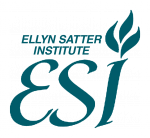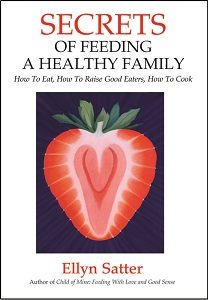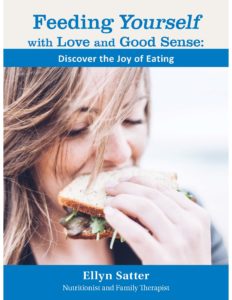

Family Meals Focus
The Ellyn Satter Institute Newsletter
ecSatter and ecSI 2.0 Give Insight on Eating Disorders
by Ellyn Satter, MS, MSSW and Jennifer Harris RDN, LD, CEDS-C
For a PDF of this issue of Family Meals Focus, click here
The Satter Eating Competence Model, ecSatter,1 as assessed by ecSI 2.0,2, 3 offers a comprehensive framework for understanding and addressing eating disorders. ecSI 2.0 can be used to screen for eating dysfunction and disorders, target intervention, and assess and address the family feeding context. ecSI 2.0 validation studies show that as ecSI 2.0 scores, and therefore Eating Competence, go up, eating disorder symptoms go down.2-4
Being Eating Competent undermines the secondary benefit of being miserable about food and eating: Being engrossed with eating and the avoidance of eating distract from the underlying life misery that sufferers regard, likely unconsciously, as being even worse.
Factor-scoring ecSI 2.0 identifies where treatment can be targeted.
ecSI 2.0 correlates with eating disorder characteristics
Distorted eating attitudes and behaviors take on the characteristics of an eating disorder when they are accompanied by, and interactive with, psychosocial limitations as measured by the Garner Eating Disorder Inventory EDI.5, 6 Research subjects who score above the normal 32 cutoff on ecSI 2.0 do not show EDI 2 or EDI 3 indicators of eating disorders. Subjects who score in the lowest ecSI 2.0 tertile (16 or below) show elevated distortions in eating, body image, and psychosocial attitudes and behaviors associated with eating disorders:2, 3
- Bulimia
- Body dissatisfaction
- Low self-esteem
- Personal alienation
- Interpersonal insecurity
- Interpersonal alienation
- Emotional dysregulation
- Maturity fears
- Interoceptive deficits
ecSI 2.0 correlates with low restraint and disinhibition
People who score in the normal range of ecSI 2.0 score low in cognitive restraint with eating, disinhibition of restraint, and difficulty coping with hunger.2, 3 All three are measured by Stunkard’s Three-Factor Eating questionnaire (TFEQ),7 and high scores on all three are characteristic of eating disorders.5, 6 Eating Competent subjects trust their internal regulators of hunger, appetite, and satiety and tolerate between-eating-time hunger, not from willpower, but from a pleasant anticipation of the next satisfying meal or snack.1
ecSI 2.0 correlates with subjective confidence, pleasure
Cognitive interviews with low-income women reveal striking attitudinal differences between women who score high and those who score low on ecSI 2.0. Women who score high relate their eating to energy, excitement, enjoyment, happiness, and relaxation. Those who score low report eating-disorder-typical attitudes and behaviors: negative thoughts and feelings about eating, chronic restriction, chaotic eating, and preoccupation with weight.8
ecSatter factors highlight eating disorder deficits
People with eating disorders score low on one or more ecSatter factors. Administering ecSI 2.0 and scoring according to individual factors helps identify where treatment can be targeted.
Eating attitudes: Positive eating attitudes lead the way to Eating Competence. Do people with eating disorders enjoy eating and feel positive and relaxed about it? Sadly, no they don’t. In the context of self-deprivation, feeling good about eating means it could go out of control! Do they trust themselves to eat as much as they want and need? No to that, as well. By the way, trusting themselves to eat as much as they need addresses internal regulation, but the statistics show this item factors under eating attitudes. Think of it as an attitude about internal regulation.
Food acceptance: Do people with eating disorders take an interest in unfamiliar food? They tend not to. Instead, they have strict food rules and virtuous beliefs about health and about good and bad foods. Positive food acceptance depends on trusting the appetite: appreciation for taste and flavor. Since they are trying to restrict and avoid, they experience appetite as being distressingly compelling and insatiable.
Internal regulation: Do people with eating disorders let themselves eat as much as they want? Next to eating attitudes, for most forms of eating disorders, external regulation of food intake is the key limitation. They typically try to eat less than their biological need and avoid high-calorie or particularly appealing foods. They compensate with increased activity or purging to perceived excesses in food intake. People with bulimia experience hunger as ever-present and overwhelming. People with anorexia ignore hunger to the degree that their awareness of it is suppressed.
Eating context: Do people with eating disorders feed themselves positively, regularly, and reliably? It depends. People with orthorexia may have a set and even rigid meal schedule. For others, every food exposure, particularly if it is enjoyable, brings with it the possibility of out-of-control eating.
Use ecSI 2.0 to screen for eating disorders
A person who scores in the lowest tertile of 16 or below on ecSI 2.02 is likely to exhibit dysfunctional eating, body image distortions, and psychosocial attitudes and behaviors associated with eating disorders. However, as with any inventory, before you recommend an eating disorder diagnosis, you must evaluate test scores in the context of clinical assessment.
- Use EDI-35 and/or the validated and no-cost EAT-269 along with ecSI 2.0 to demonstrate the credence of ecSI 2.0 scores to other eating disorders specialists.
- Cautiously interpret low ecSI 2.0 scores, even when used as part of a battery of tests. Only clinical examination can determine whether the person truly has an eating disorder. Also consider that scores may decrease during treatment as self-awareness and trust increase.
- Until the scoring norms are established by further research, help accumulate a body of knowledge about typical ecSI 2.0 scores and symptoms of disordered eating. ESI Faculty Member Cristen Harris does training on doing clinical research10 and can help get your contribution into print.
- Because ecSI 2.0 has been demonstrated to have test/retest reliability,11 you can administer ecSI 2.0 before, during, and after intervention to support evidence-based clinical practice. Scores may continue to vary as individuals work through their recovery.
What this means for your practice
Working within the context of ecSatter is organizing and powerful with respect to addressing eating disorders. ecSI 2.0 can be used for screening, and factor-scoring ecSI 2.0 gives direction for treatment. Assessing and addressing parent Eating Competence enhances the effectiveness of family-based treatment for eating disorders.12 Eating Competence is the ultimate goal of the treatment for any eating disorder. With children and adolescents, that goal can be accomplished indirectly through parents’ knowledgeable use of the Satter Division of Responsibility in Feeding.13 The 40-page booklet, Feeding with Love and Good Sense: 12 through 18 years,14 offers guidance for parents with respect to taking leadership and giving autonomy in feeding their teen.
References
1. Satter E. Eating Competence: definition and evidence for the Satter Eating Competence Model. J Nutr Educ Behav.2007;39:S142-S153.2. Krall JS, Lohse B. Validation of a measure of the Satter Eating Competence model with low-income females. Int J Behav Nutr Phys Act. 2011;8. doi:10.1186/1479-5868-8-26 PMC3094263,3. Lohse B, Satter E, Horacek T, et al. Measuring Eating Competence: psychometric properties and validity of the ecSatter Inventory. J Nutr Educ Behav. 2007;39:S154-S166.4. Lohse B. The Satter Eating Competence Inventory for Low-income persons is a valid measure of Eating Competence for persons of higher socioeconomic position. Appetite. 2015;87:223-228.5. Garner DM. Eating Disorders Inventory 3. Psychological Assessment Resources, Inc.; 2000.6. Garner DM. Eating Disorders Inventory 2. Psychological Assessment Resources, Inc.; 1991.7. Stunkard AJ, Messick S. The three-factor eating questionnaire to measure dietary restraint, disinhibition and hunger. J Psychosom Res. 1985;29:71-83.8. Krall JS, Lohse B. Cognitive testing with female nutrition and education assistance program participants informs validity of the Satter eating competence inventory. J Nutr Educ Behav. 2010;42:277-283.9. Garner DM, Olmsted MP, Bohr Y, Garfinkel PE. The eating attitudes test: psychometric features and clinical correlates. Psychol Med. 1982;12:871-878.10. Harris C. ESI webinar. Researching Satter: Strengthening the Evidence-Base for the Satter Models.https://www.ellynsatterinstitute.org/product/prof-web-evidence/11. Stotts JL, Lohse B. Reliability of the ecSatter Inventory as a tool to measure eating competence. J Nutr Educ Behav.2007;39:S167-70.12. Harris J. Parent Eating Competence: Considerations in Eating Disorder Treatment.https://www.ellynsatterinstitute.org/product/parent-eating-competence-considerations-in-eating-disorder-treatment/13. Harris J. The Last Chapter: Eating Disorder Care, Transitioning Back to sDOR.https://www.ellynsatterinstitute.org/product/the-last-chapter/14. Satter E. Feeding with Love and Good Sense: 12 through 18 years. Kelcy Press; 2018.https://www.ellynsatterinstitute.org/product/feeding-with-love-and-good-sense-12-through-18-years/
Explore
Understand and Apply ecSatter
Measure Eating Competence
ecSatter and eating disorders
Ellyn Satter’s Secrets of Feeding a Healthy Family says the secret of raising a healthy eater is to love good food, enjoy eating, and share that love and enjoyment with your child. When the joy goes out of eating, nutrition suffers.


